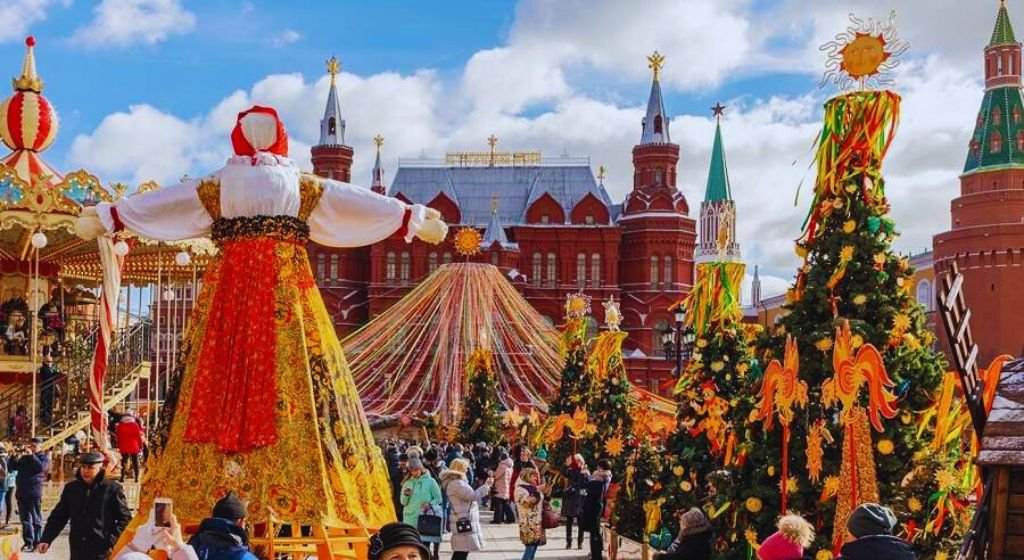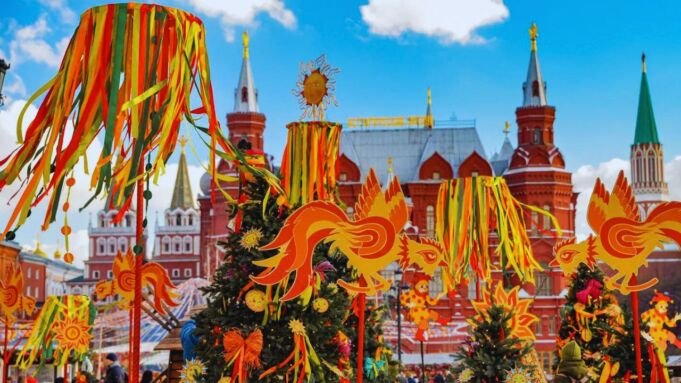Maslenitsa, a vibrant and exuberant Russian festival, marks the transition from winter’s chill to the hopeful warmth of spring. Known as Pancake Week or Butter Week, this jubilant event combines ancient pagan traditions with Christian customs, celebrating the imminent arrival of Lent.
Maslenitsa’s rich history and festive activities offer a glimpse into Russia’s cultural heritage and communal spirit. This article delves into the traditional customs, sumptuous culinary delights, and the modern-day celebrations of Maslenitsa, illuminating why it remains a cherished event in the Russian calendar.
What is Russian Maslenitsa?
Russian Maslenitsa is a traditional folk holiday celebrated in the last week before Orthodox Lent, symbolizing the farewell to winter and welcoming of spring. This vibrant week, also known as Pancake Week or Butter Week, features an array of festive activities, including the making and eating of blini—round, golden pancakes that represent the sun.
Maslenitsa blends both pagan traditions of seasonal renewal and Christian customs of preparing for Lent, culminating in the “Forgiveness Sunday” where people seek reconciliation and forgiveness from each other. The week is filled with joyous celebrations, lively folk music, and the burning of the Maslenitsa effigy, embodying the spirit of rejuvenation and communal unity.
The Historical Origins of Maslenitsa
Maslenitsa, a tradition with roots in pagan times, marks the transition from winter to spring in Russia. This festival has both pagan and Christian origins. Historically, pagans celebrated Maslenitsa on the vernal equinox to welcome spring and rejoice in the renewed life and warmth it brought.
From a Christian perspective, Maslenitsa represents the final week before Lent, offering one last opportunity to indulge in secular pleasures before the strict fasting period leading up to Easter. During Lent, meat, fish, dairy products, and eggs are avoided, and activities like parties, secular music, and dancing are set aside to focus on spiritual growth.
Maslenitsa, named after the Russian word “maslo,” meaning butter or oil, is closely associated with pancakes, or blini. These pancakes, traditionally made from buckwheat flour and known for their golden, round shape, symbolize the sun and are thought to help warm the frozen earth. They play a crucial role in the festivities, embodying a sliver of sunlight and warmth.
Related: Regatta De Zamboanga Festival
How Did Maslenitsa Begin?
Maslenitsa shares characteristics with several Western celebrations like Mardi Gras and Shrovetide. However, it uniquely combines Orthodox Christian traditions with ancient pagan customs. These pagan roots date back to as early as the 2nd century AD, commemorating the end of winter and the onset of spring.
How Long Does Maslenitsa Last?
Maslenitsa lasts for an entire week, serving as the final celebration before the onset of Orthodox Lent. This festive week begins on a Monday and concludes on the following Sunday, known as “Forgiveness Sunday,” where participants seek forgiveness from one another, symbolically preparing for the Lenten period of reflection and fasting.
Each day of the week has specific customs and traditions, making Maslenitsa a dynamic and continuously engaging festival.
Read More: Guatemala’s Festivals and Traditions
Traditional Celebrations and Rituals
Traditional celebrations and rituals of Maslenitsa offer a vibrant glimpse into Russian folklore, featuring festive activities like blini feasting, folk dancing, and the symbolic burning of the Maslenitsa effigy.
Key Activities Throughout the Week
Each day of Maslenitsa week is marked by specific activities. The week starts with the welcoming of “Lady Maslenitsa,” and includes festive gatherings, vibrant performances of folk music and dancing, sledding, and snowball fights. The week concludes with “Forgiveness Sunday,” where people ask forgiveness from friends and family, setting the stage for Lent with a clean moral slate.
Culinary Traditions
Maslenitsa is also affectionately termed “Butter Week” due to the copious use of butter, particularly in making blini. These pancakes are made from rich dough that includes eggs, butter, and milk, and are served laden with honey, caviar, fresh cream, or jam. The round, warm blini are symbolic of the sun, embodying the hope of returning light and warmth with the advent of spring.
6 Things You Should Know About Maslenitsa

- A Rich Blend of Traditions: Maslenitsa, often referred to as Pancake Week or Butter Week, is a traditional Russian festival that heralds the arrival of spring. It is a unique fusion of pagan past and Christian traditions, originally celebrated as a sun festival by the pagan Slavs. With the adoption of Christianity in Russia, it transformed into a pre-Lenten festival celebrated in the week before Orthodox Lent.
- The Symbolism of Blini: Blini, or Russian pancakes, are the quintessential food of Maslenitsa. Made from rich ingredients like butter, eggs, and milk, these round, golden pancakes are symbolic of the sun. Serving and eating blini is a way to welcome the return of warmth and light after the long, dark winter months.
- Festivities and Customs: Maslenitsa is characterized by a variety of joyful activities. The week-long celebration includes sledding, snowball fights, folk dancing, and singing. People also visit friends and family, engage in festive eating, and participate in masquerade balls. A highlight is the burning of the “Lady Maslenitsa” effigy, which symbolizes the driving away of winter.
- Day-Specific Celebrations: Each day of Maslenitsa week has specific traditions and activities. For instance, Monday is for welcoming “Lady Maslenitsa,” Tuesday focuses on playful pursuits like sledding and games, Wednesday is reserved for sweet treats and the feasting of blini, and Sunday, known as Forgiveness Sunday, is when everyone asks forgiveness from one another, cleansing their spirits before Lent.
- Culinary Delights: While blini are the stars of the show, other foods also feature prominently during Maslenitsa. These include caviar, honey, jams, and sour cream. Since it’s the last week before the Lenten fast, dairy products are consumed in large quantities, along with other foods that will be forbidden during Lent.
- Modern Celebrations and Cultural Impact: In modern times, Maslenitsa continues to be a popular festival across Russia and in Russian communities worldwide. Cities and towns host public celebrations that include concerts, fairs, and other cultural events, making it a significant time for community bonding and cultural pride. These celebrations help keep the rich Russian cultural heritage alive and introduce these traditions to a broader, global audience.
Maslenitsa in Modern Times
In contemporary Russia, Maslenitsa remains a beloved cultural event, blending traditional festivities with modern celebrations. Across the country, vibrant parades, folk performances, and culinary feasts mark this joyous farewell to winter.
Current Celebrations
Today, Maslenitsa is celebrated all over Russia with a blend of traditional and modern festivities. Major cities host concerts, set up festive markets, and encourage public participation in historical reenactments and traditional games. The week remains a popular time for Russians to indulge in the joys of winter sports and activities, with a communal spirit pervading the celebrations.
Cultural Impact and Preservation
Efforts to preserve Maslenitsa traditions are robust, as the festival plays a crucial role in maintaining Russian cultural identity. Educational programs and cultural festivals highlight the importance of Maslenitsa, ensuring that the rich customs and folklore associated with this week-long celebration are passed down through generations.
Read Also: Best Places to Visit in Peru
Maslenitsa in the Diaspora
Russian communities worldwide continue to embrace Maslenitsa, organizing events that feature traditional music, dance, and of course, the making and sharing of blini. In countries like the USA and Canada, these celebrations not only nurture the cultural ties of the diaspora but also introduce these rich traditions to a broader audience.
Why do They Burn Maslenitsa?
Maslenitsa, rooted in pagan tradition, represents the struggle between winter and spring as the seasons change. The triumph of spring is celebrated by the ceremonial burning of a scarecrow, known as Lady Maslenitsa, which personifies winter.
What is the Maslenitsa in Mythology?
Maslenitsa rooted in pagan tradition, represents the struggle between winter and spring as the seasons change. The triumph of spring is celebrated by the ceremonial burning of a scarecrow, known as Lady Maslenitsa, which personifies winter.
Conclusion
Maslenitsa’s enduring appeal lies in its ability to blend solemnity with revelry, and tradition with modernity, all while fostering community bonds and cultural identity. As both Russia and its global diaspora continue to celebrate this colorful festival, Maslenitsa remains a vibrant expression of life’s cyclical renewal and cultural continuity, cherished by generations past and present.
Also Read: Most Visited Cities in the World
Frequently Asked Questions (FAQs) About Maslenitsa
Explore common questions about Maslenitsa, the vibrant Russian festival celebrating the end of winter and the arrival of spring.
What is Maslenitsa?
Maslenitsa is a traditional Russian festival marking the end of winter and the arrival of spring. It blends pagan traditions celebrating the rebirth of nature with Christian customs leading into the Lenten season.
When is Maslenitsa celebrated?
Maslenitsa is observed during the last week before Orthodox Lent, typically falling in late February or early March, depending on the year.
Why are pancakes (blini) associated with Maslenitsa?
Pancakes, or blini, are a staple of Maslenitsa because their round, golden shape symbolizes the sun, which is celebrated for returning warmth to the earth and ending the cold winter.
What are some common traditions of Maslenitsa?
Common traditions include the making and eating of blini, festive snowball fights, sled rides, folk dancing, and the burning of the Lady Maslenitsa effigy, which symbolizes the end of winter.
Is it true that Maslenitsa includes a “Forgiveness Sunday”?
Yes, the final day of Maslenitsa is known as Forgiveness Sunday, where individuals seek forgiveness from each other to cleanse their spirits before entering the solemn Lenten season.
Can anyone participate in Maslenitsa celebrations?
Maslenitsa is a community-focused event that welcomes participation from anyone interested in experiencing and enjoying this vibrant cultural festival.
How has Maslenitsa changed in modern times?
While retaining many traditional elements, modern Maslenitsa celebrations may also include concerts, public art displays, and charity events, making it a blend of historical customs and contemporary festivities that appeal to a wide audience.










![What Does Aviates Stand for in Aviation? [The Art of Flying] Aviates](https://tourinplanet.com/wp-content/uploads/2024/07/Aviates-100x75.jpg)














![25 Best Peruvian Foods You Must Try In Peru [With Recipes] Peruvian Food](https://tourinplanet.com/wp-content/uploads/2024/07/Peruvian-Food-100x75.jpg)


